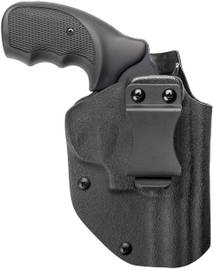
- SMITH AND WESSON MODEL 10 HOLSTER SERIAL NUMBERS
- SMITH AND WESSON MODEL 10 HOLSTER FULL
- SMITH AND WESSON MODEL 10 HOLSTER SERIES
Tracer ammunition was manufactured for signaling purposes.
SMITH AND WESSON MODEL 10 HOLSTER FULL
Although the latter personnel could use conventional lead bullets, Remington Arms manufactured REM UMC 38 SPL headstamped cartridges loaded with a 158 gr (10.2 g) full metal jacket bullet for military use in overseas combat zones. The Victory Model was a standard-issue sidearm for United States Navy and Marine Corps aircrews, and was also used by security guards at factories and defense installations throughout the United States during the war. 38 Special cartridge were used by United States forces during World War II. Īn additional 352,315 Victory Model revolvers chambered in the well-known and popular. Thousands of Victory Model revolvers remained in United States Army inventories following World War II for arming foreign military and security personnel. The Office of Strategic Services (OSS) supplied thousands of these revolvers to resistance forces. The 5-inch barrel was standard production after 4 April 1942. Most Victory Models sent to Britain were fitted with 4-inch or 5-inch barrels, although a few early versions had 6-inch barrels.

38/200 caliber already in use in the Enfield No 2 Mk I Revolver and the Webley Mk IV Revolver. During World War II 590,305 of these revolvers were supplied to the United Kingdom, Canada, Australia, New Zealand, and South Africa under the Lend-Lease program, chambered in the British. Early Victory Models did not always have the V prefix.
SMITH AND WESSON MODEL 10 HOLSTER SERIAL NUMBERS
The S&W M&P military revolvers produced from 1942 to 1944 had serial numbers with a "V" prefix, and were known as the Smith & Wesson Victory Model. It would also become very popular with civilian shooters, with several new models being made, including the first snubnosed 2-, 2.5- and 3-inch barrel models being made in 1936. Although WWI saw the rise of semi-automatic pistols, revolvers such as the M&P were used in vast numbers as semi-automatic handgun production at the time wasn't sufficient to meet the demand.Īfter the War, the M&P would become the standard issue police sidearm for the next 70 years. The M&P revolver was issued in large numbers during World War I, where it proved itself to be a highly reliable and accurate weapon. 38 S&W Military & Police Model of 1905 4th Change, introduced 1915, incorporated a passive hammer block and enlarged service sights that quickly became a standard across the service revolver segment of the industry. The lock mechanism remained principally unchanged after this model.

The M&P 1905 Fourth Change variant (1915). 38 M&P with a rounded or square butt, and 4-, 5-, and 6.5-inch barrels. 38 Special appear to have been sold to the civilian market. Most of the early M&P revolvers chambered in.
SMITH AND WESSON MODEL 10 HOLSTER SERIES
Serial numbers for the Military & Police ranged from number 1 in the series to 20,975. Barrel lengths were 4-, 5-, 6-, and 6.5-inches with a rounded butt. These included major modification and simplification of the internal lockwork and the addition of a locking underlug on the barrel to engage the previously free-standing ejector rod. 38 Military & Police (2nd Model) was introduced and featured substantial changes. 38 Long Colt cartridge with greater bullet weight (158 grains) and powder charge increased from 18 to 21 grains of gunpowder. 38 S&W Special (a.k.a.38 Special), a slightly elongated version of the.


That same year, in response to reports from military sources serving in the Philippines on the relative ineffectiveness of the new cartridge, Smith & Wesson began offering the Military & Police in a new chambering. With this order, the Hand Ejector Model became known as the. In 1899, the United States Army and Navy placed orders with Smith & Wesson for two to three thousand Model 1899 Hand Ejector revolvers chambered for the M1892. The trigger return spring is a flat leaf rather than the coil spring-powered slide used in variations dating from 1905 onwards. The lockwork of the first model differed substantially from subsequent versions. Some 6,000,000 of the type have been produced over the years, making it the most popular handgun of the 20th century. Barrels of 2.5 inches (64 mm) are also known to have been made for special contracts. 38 Special, double-action revolver with fixed sights. In production since 1899, the Model 10 is a six-shot. 38 Hand Ejector Model of 1899, the Smith & Wesson Military & Police or the Smith & Wesson Victory Model, is a K-frame revolver of worldwide popularity. The Smith & Wesson Model 10, previously known as the Smith & Wesson. Lend-Lease M&P dating from World War II, missing lanyard ring


 0 kommentar(er)
0 kommentar(er)
